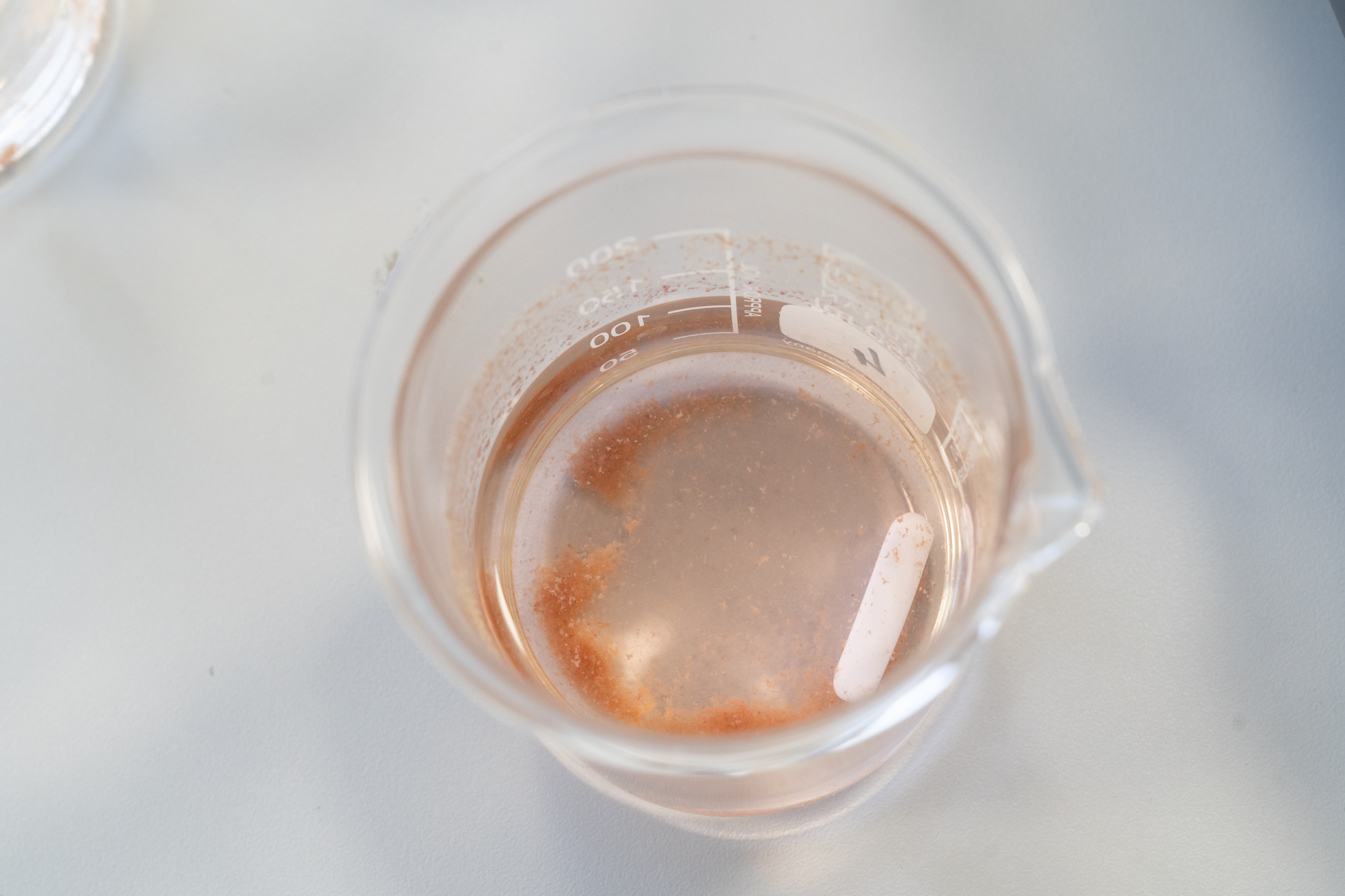LaChiPur
Functionalized Chitosan as a Biobased Flocculant for the Treatment of Complex Wastewater
Researchers at the Fraunhofer Institute for Interfacial Engineering and Biotechnology IGB have developed a biobased and functionalized flocculant to efficiently treat complex wastewaters. Furthermore, toxic phenols are removed from the water by the enzyme laccase in a chitosan matrix. The functionalized and degradable flocculant LaChiPur will be presented for the first time at the IFAT in Munich from May 13–17, 2024.


Through flocculation, finest solid impurities are removed during wastewater purification and water treatment. Flocculants cause suspended solids to agglomerate into larger flocs, which sink to the bottom or can be filtered – the water becomes clear again. Inorganic metal salts, such as iron or aluminum sulfates and chlorides, are frequently utilized to remove humic substances in drinking water treatment, to treat process water during paper production, or to precipitate phosphorus in municipal wastewater treatment plants. In some cases, polymer flocculants, synthetic polymers made from fossil resources, are additionally included. The obvious disadvantage of conventional methods: due to the added chemicals or polymers, the resulting sludge cannot be reused and has to be disposed of at great expense.
This is why researchers at the Fraunhofer Institute for Interfacial Engineering and Biotechnology IGB turned to natural and completely biodegradable chitosan. This is obtained from renewable chitin, which is contained as a structural component in the shells of crustaceans, the shells and skins of insects and in fungi, making chitin one of the most common natural polymers on earth – second only to plant-based cellulose.
New technology with natural biobased raw materials
Chitosan-based water treatment chemicals are already available for purifying swimming pools and ponds. However, Fraunhofer researchers are taking this approach one step further by additionally functionalizing chitosan with the enzyme laccase. The enzyme is found in various plants, fungi and bacteria. In nature, laccases are involved in both connecting aromatic monomers to form lignin and in its removal. Because of their ability to oxidize phenols and other phenolic substances, they are in high demand for various industrial applications, whether during removal of toxic phenols in fruit juices, the decolorization of textile wastewater, or the removal of pollutants in water and soil.
“Our idea was that laccase – bound to chitosan as a matrix – could also be suitable for complex wastewaters, like those generated during the production of wine or olive oil,” says Dr. Thomas Hahn, who’s research at Fraunhofer IGB comprises the purification of chitin from a wide variety of waste streams and its subsequent conversion to chitosan. After the grape harvest, municipal wastewater treatment plants quickly reach their limits when three to four times the normal volume of wastewater reaches the predominantly small wastewater treatment plants in rural wine-growing areas. “The phenols in the wastewater have a toxic effect on the bacteria in the aeration tank. As a result, aeration has to be increased, which significantly raises the energy requirements of the wastewater treatment plant,” says Marc Beckett, an expert in water management and water treatment at the IGB. In olive oil mills, wastewater from washing and oil extraction is often stored large collecting ponds, where the water evaporates over time and leaves behind a sludge that is toxic to flora and fauna.
The idea turned into a two-year Fraunhofer research project, which was funded as part of the “rapid SME-oriented in-house research (SME)” program until December 2023. The IGB team partnered with the Fraunhofer Institute for Applied Polymer Research IAP in Potsdam, who worked on the functionalization of chitosan with laccase. In order to be able to test the effect of chitosan functionalized with laccase using real wastewater, researchers at the IGB first established the corresponding methodology and analytics. “One of the challenges was bringing the polymeric chitosan into solution, allowing it to be dosed as a flocculant and develop its effect of binding polyphenols and tannins,” recalls Hahn. “As a slightly acidic environment is ideal for laccase, we immediately achieved very promising results for the typical wastewater from wine or olive oil production,” says the chemist.
Phenolic substances are also removed
“Our technology achieves a flocculation performance for complex agro-industrial wastewater that is comparable to that of conventionally used coagulants containing metal salts or synthetic polymer flocculants. However, LaChiPur, as we call our functionalized product, is completely biobased and therefore biodegradable,” summarizes Beckett, biologist and environmental scientist. The combination with laccase proved to be a real advantage with this wastewater, as the functionalized chitosan can be used as a flocculant, and oxidizes and polymerizes phenols at the same time.
Local production and diverse applications
Further advantages of the new environmentally friendly technology: the raw material chitin is produced locally in large quantities as waste in the food or biotechnology industry. This ensures economical production and security of supply – without the dependencies of intertwined international supply chains. If the degradable sludge produced after flocculation is fermented in sewage treatment plants, this can even significantly increase the biogas yield.
“Thanks to our interdisciplinary expertise, we can now examine the wastewater and process water produced in industrial companies in our laboratory to see how the water treated with LaChiPur is purified,” say Hahn and Beckett. Based on the initial promising results, the researchers also want to further optimize their technology with small and medium-sized companies that sell or manufacture flocculants, transfer it to a larger scale and bring it into industrial application. “LaChiPur is furthermore suitable as filter material and has the properties of precipitants. We also seek to further develop our product for use in phosphorus precipitation. Due to its properties, it is also of interest for the purification of textile wastewater or for use in drinking water treatment,” the IGB scientists are convinced. From May 13–17, 2024, they will be presenting LaChiPur at the joint stand of the Fraunhofer Water Systems Alliance (SysWasser) in hall B2, booth 338 at the IFAT in Munich.
 Fraunhofer Institute for Interfacial Engineering and Biotechnology IGB
Fraunhofer Institute for Interfacial Engineering and Biotechnology IGB